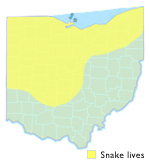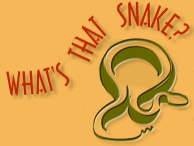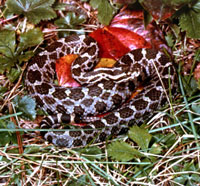WARNING!
WARNING! The Eastern Massasauga Rattlesnake is a venomous snake. Although smaller than the other two venomous snakes in Ohio, this rattler still is very dangerous to people and their pets. If you think one of these snakes has bitten someone, seek medical help immediately.
Latin name
Sistrurus catenatus catenatus
Fast facts
Appearance
The Eastern Massasauga Rattlesnake is dark colored and stocky with a thick, triangular shaped head. There are dark stripes on both sides and top of the head. The body is marked along back and sides with rounded dark blotches against a gray or brownish gray background. This snake has a rather small, but noticeable, rattle on the end of its tail.
Some adults are completely black except for the chin and throat. As with the other two venomous snakes in Ohio, the eyes of the Eastern Massasauga Rattlesnake have vertical pupils, while those of the non-venomous snakes have round pupils. The young are well marked with contrasting colors but are lighter in color than the adults.
Range
Overall Range
The Eastern Massasauga Rattlesnake ranges from western New York and southern Ontario to eastern Iowa and Missouri.
Range in Ohio
Today, this snake occurs in isolated places in glaciated parts of western and northern Ohio.

Local Habitat
This snake lives in bogs, swamps, and wet prairies.
Lifestyle
The word "massasauga" comes from the Chippewa language meaning "great river mouth." This is because of its habitat of swamps, which are often found around the mouths of rivers. It is also known as the 'swamp rattler" and "black snapper." The venomous Eastern Massasauga Rattlesnake rarely attempts to bite unless highly agitated. Its venom is very toxic, but healthy adult humans rarely die from a bite because its teeth are too small to inject enough for great harm. However, a bite should still be considered very dangerous.
During the spring and autumn the Eastern Massasauga Rattlesnake is diurnal and often is found sunning itself. During the hot summer months, however, this snake is crepuscular or nocturnal, and rarely is seen. Unlike the Eastern Timber Rattlesnake, this snake hibernates alone, often in crayfish or small mammal burrows. People are the biggest threat to Massasauga Rattlesnakes, but larger snakes such as the racers are known to eat them. Extensive farming and the draining of swamplands have drastically reduced their numbers.
More information

